人教版高中英语必修四 unit 4 Body language reading 课件 (共24张PPT)
文档属性
| 名称 | 人教版高中英语必修四 unit 4 Body language reading 课件 (共24张PPT) | 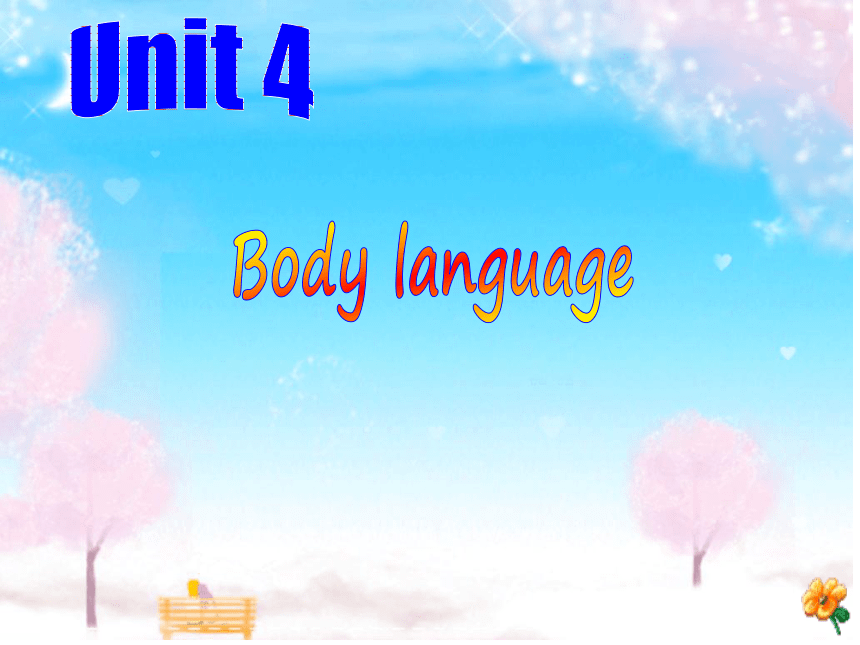 | |
| 格式 | zip | ||
| 文件大小 | 1.4MB | ||
| 资源类型 | 教案 | ||
| 版本资源 | 人教版(新课程标准) | ||
| 科目 | 英语 | ||
| 更新时间 | 2018-12-03 21:16:32 | ||
图片预览



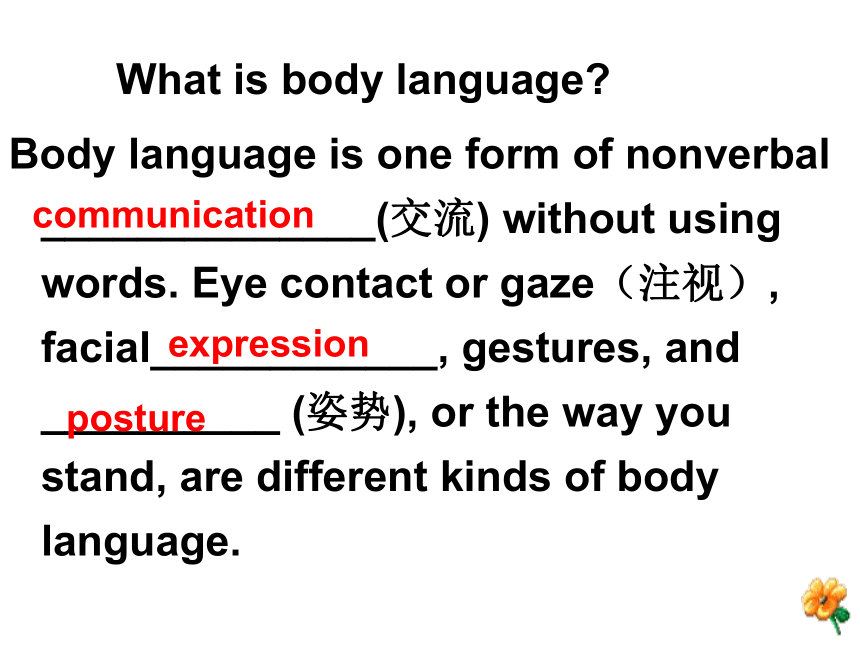

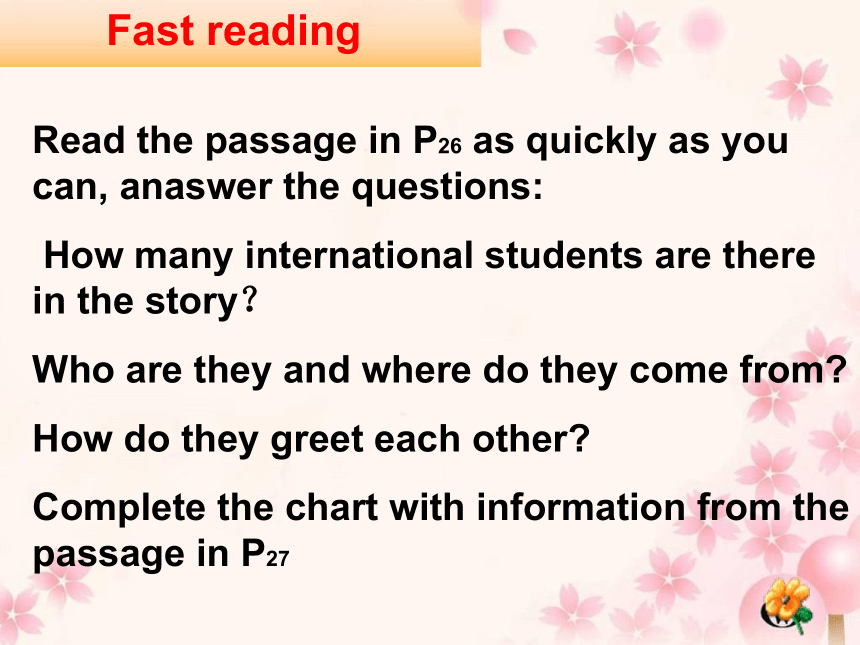
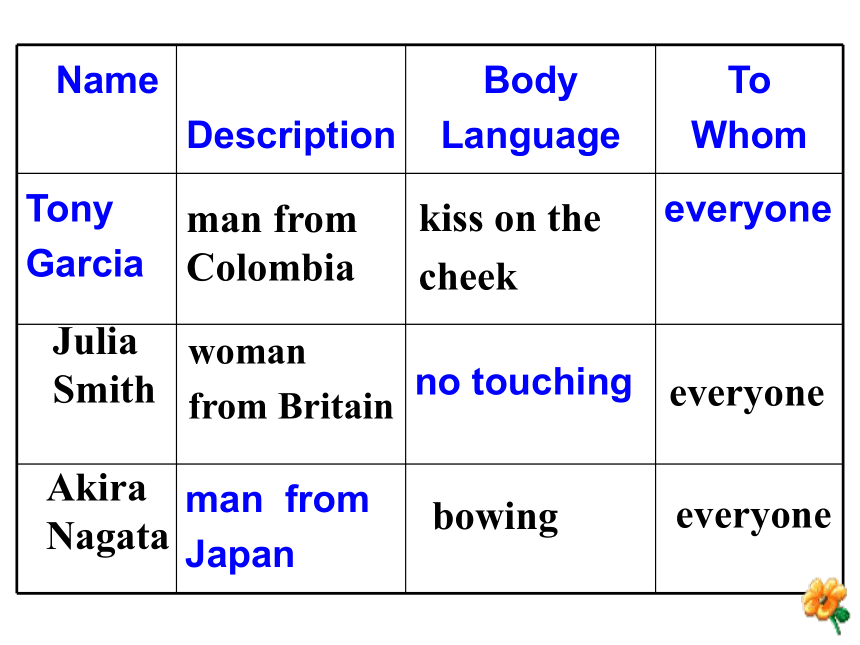
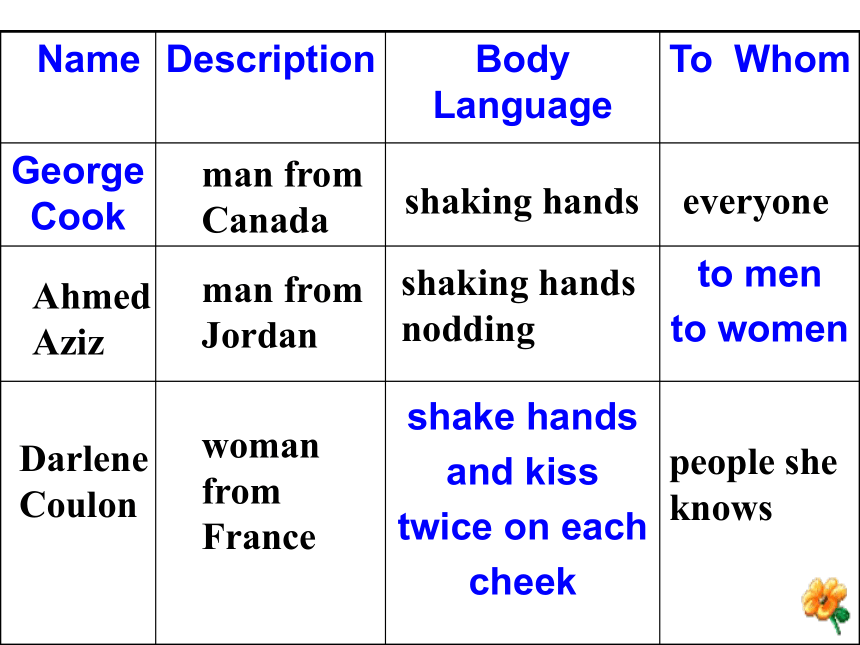
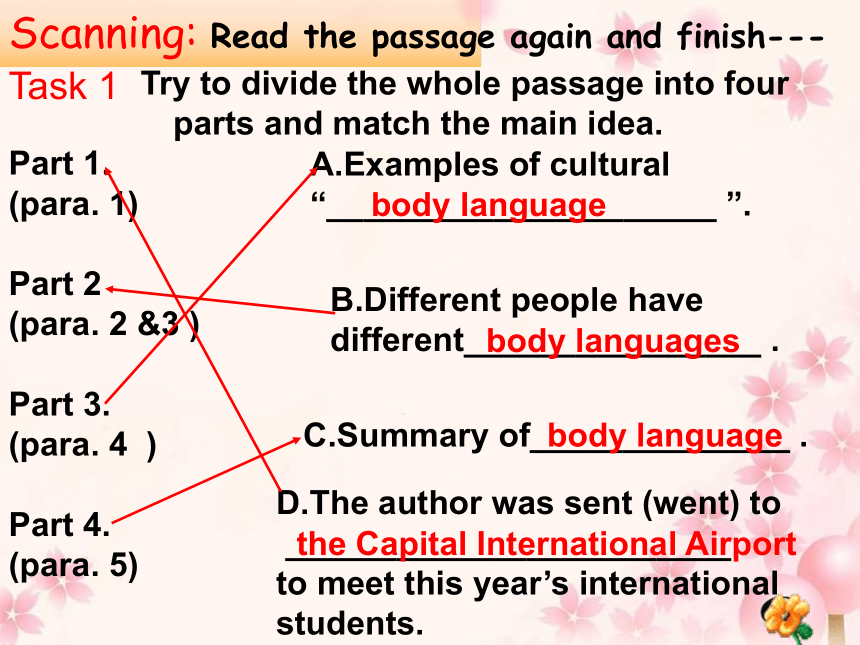
文档简介
课件24张PPT。Unit 4Body languageRevisionspeakingringingwritingtypingSpoken
languageWritten
languageBody
languageWays of communicatinggesturefacial expressionaction What is body language?
Body language is one form of nonverbal ______________(交流) without using words. Eye contact or gaze(注视), facial____________, gestures, and __________ (姿势), or the way you stand, are different kinds of body language.communicationexpressionpostureReadingCommunication:
No problem?Fast readingRead the passage in P26 as quickly as you can, anaswer the questions:
How many international students are there in the story?
Who are they and where do they come from?
How do they greet each other?
Complete the chart with information from the passage in P27man from Colombiakiss on the cheekJulia Smithwoman from BritaineveryoneAkira Nagatabowing everyoneman from Canada shaking handseveryoneAhmed Aziz man from Jordanshaking hands noddingDarlene Coulonwoman from Francepeople she knows Scanning: Read the passage again and finish--- Try to divide the whole passage into four parts and match the main idea.
Part 1.
(para. 1)
Part 2
(para. 2 &3 )
Part 3.
(para. 4 )
Part 4.
(para. 5) A.Examples of cultural “_____________________ ”.B.Different people have different________________ .C.Summary of______________ .
D.The author was sent (went) to
________________________
to meet this year’s international students.body languagebody languagesbody languagethe Capital International AirportTask 1Discuss and try to sum up the main idea: This text mainly talks about that
different __________________
have different _______ languages.Task 2countries/cultures/peopleboby(1). Englishmen often stand close to others or touch strangers as soon as they meet. ( )
(2).Most people around the world now greet each other by shaking hands . ( )
(3).Japanese will bow to others as greeting. ( )
(4). People from Jordan will move very close to you as you introduce yourself to them. ( )Task 3:Decide if the following statements are
true (T) or false (F). TFTT(5). People from Jordan will shake hands with a woman as she introduces herself to them. ( )
(6). Some body languages in some countries are good while some countries’ body language are bad. ( )
(7). People from different countries may have a major misunderstanding while greeting each other. ( )
(8). The physical distance from each other that people are comfortable with generally depends on the culture. ( )
(9). All members of a culture behave in the same way. ( )
TFFTFCareful- readingListen to the tape and fill in the blanksTask 1Mr. Garcia Julia SmithThe first groupfromfrom(Columbia )(Britain)He approaches Ms Smith by _______ ______ _________ and _______ her on the ________.She ______ ________ appearing _________ and take a few steps _______ ______ Mr. Garcia.shouldertouchingherkissingcheeksteps backsurprisedaway fromThe second groupa JapaneseGeorge Cookfrom(Canada)He ________ ________ _______ ________ to the Japanese.He ________ to Mr. Cook and his nose _________ Mr. Cook’s _______ ________.bowstouchesmovinghandreaches his handoutThe third groupAhmed Aziz “You”from(China)You ___________
a bit.He moves very _________to you and _______________.closeshakes your handmove backRead the passage carefully , discuss and choose the correct answersTask 2A. Two university students meet the
international students in the airport.
B. Men and women use different body
languages in foreign countries.
C. Different cultures have different body
languages.
D. There are different kinds of cultures
in the world. 1. What does the text mainly talk about?2. What can we infer from the text?
A. A boy from Spain is likely to touch
the people he meets.
B. Physical distance can’t send out a
message.
C. English people may stand very close
to their friends.
D. It’s friendly to touch Muslim women. 3. From the passage we know, most
international students greet others by ______.
A. shaking hands
B. bowing
C. kissing
D. touching shoulders4. Which of the following is true?
A. French people often greet people by kissing each other on both cheeks.
B. All people around the world now greet people by shaking hands.
C. People from Britain and from South American countries seem to prefer to keep more physical distance from others.
D. Not knowing foreign customs may cause a cultural mistake. Conclusion: This text mainly talks about that different ________________have different ________language. Different countries have ___________(不同) cultures, when people greet each other, they will have different_______(方式). If people don’t know the cultural differences well, people may have difficulties in________________(交流) with others throughout the world.So we should pay attention to :countries/cultures/
peoplebobydifferentwayscommunicatingIs the author of this passage male or female? How do you know?
The author is male. Ahmed Aziz will not shake hands with women, but he shakes hands with the author.Post-reading Disuss and answer the following questionThank you for listening
languageWritten
languageBody
languageWays of communicatinggesturefacial expressionaction What is body language?
Body language is one form of nonverbal ______________(交流) without using words. Eye contact or gaze(注视), facial____________, gestures, and __________ (姿势), or the way you stand, are different kinds of body language.communicationexpressionpostureReadingCommunication:
No problem?Fast readingRead the passage in P26 as quickly as you can, anaswer the questions:
How many international students are there in the story?
Who are they and where do they come from?
How do they greet each other?
Complete the chart with information from the passage in P27man from Colombiakiss on the cheekJulia Smithwoman from BritaineveryoneAkira Nagatabowing everyoneman from Canada shaking handseveryoneAhmed Aziz man from Jordanshaking hands noddingDarlene Coulonwoman from Francepeople she knows Scanning: Read the passage again and finish--- Try to divide the whole passage into four parts and match the main idea.
Part 1.
(para. 1)
Part 2
(para. 2 &3 )
Part 3.
(para. 4 )
Part 4.
(para. 5) A.Examples of cultural “_____________________ ”.B.Different people have different________________ .C.Summary of______________ .
D.The author was sent (went) to
________________________
to meet this year’s international students.body languagebody languagesbody languagethe Capital International AirportTask 1Discuss and try to sum up the main idea: This text mainly talks about that
different __________________
have different _______ languages.Task 2countries/cultures/peopleboby(1). Englishmen often stand close to others or touch strangers as soon as they meet. ( )
(2).Most people around the world now greet each other by shaking hands . ( )
(3).Japanese will bow to others as greeting. ( )
(4). People from Jordan will move very close to you as you introduce yourself to them. ( )Task 3:Decide if the following statements are
true (T) or false (F). TFTT(5). People from Jordan will shake hands with a woman as she introduces herself to them. ( )
(6). Some body languages in some countries are good while some countries’ body language are bad. ( )
(7). People from different countries may have a major misunderstanding while greeting each other. ( )
(8). The physical distance from each other that people are comfortable with generally depends on the culture. ( )
(9). All members of a culture behave in the same way. ( )
TFFTFCareful- readingListen to the tape and fill in the blanksTask 1Mr. Garcia Julia SmithThe first groupfromfrom(Columbia )(Britain)He approaches Ms Smith by _______ ______ _________ and _______ her on the ________.She ______ ________ appearing _________ and take a few steps _______ ______ Mr. Garcia.shouldertouchingherkissingcheeksteps backsurprisedaway fromThe second groupa JapaneseGeorge Cookfrom(Canada)He ________ ________ _______ ________ to the Japanese.He ________ to Mr. Cook and his nose _________ Mr. Cook’s _______ ________.bowstouchesmovinghandreaches his handoutThe third groupAhmed Aziz “You”from(China)You ___________
a bit.He moves very _________to you and _______________.closeshakes your handmove backRead the passage carefully , discuss and choose the correct answersTask 2A. Two university students meet the
international students in the airport.
B. Men and women use different body
languages in foreign countries.
C. Different cultures have different body
languages.
D. There are different kinds of cultures
in the world. 1. What does the text mainly talk about?2. What can we infer from the text?
A. A boy from Spain is likely to touch
the people he meets.
B. Physical distance can’t send out a
message.
C. English people may stand very close
to their friends.
D. It’s friendly to touch Muslim women. 3. From the passage we know, most
international students greet others by ______.
A. shaking hands
B. bowing
C. kissing
D. touching shoulders4. Which of the following is true?
A. French people often greet people by kissing each other on both cheeks.
B. All people around the world now greet people by shaking hands.
C. People from Britain and from South American countries seem to prefer to keep more physical distance from others.
D. Not knowing foreign customs may cause a cultural mistake. Conclusion: This text mainly talks about that different ________________have different ________language. Different countries have ___________(不同) cultures, when people greet each other, they will have different_______(方式). If people don’t know the cultural differences well, people may have difficulties in________________(交流) with others throughout the world.So we should pay attention to :countries/cultures/
peoplebobydifferentwayscommunicatingIs the author of this passage male or female? How do you know?
The author is male. Ahmed Aziz will not shake hands with women, but he shakes hands with the author.Post-reading Disuss and answer the following questionThank you for listening
同课章节目录
